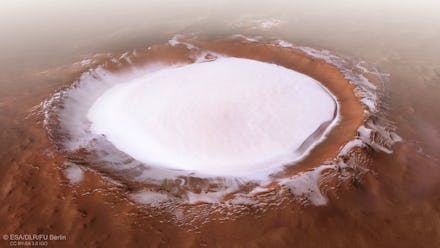Scientists may have stumbled on new 'water ice' just below the surface of Mars

When it comes to exploring the galaxy and finding planets that could ever be suitable for habitation, there's one absolute imperative that must be available there: water. Water is an essential when it comes to any sort of potential living space for humanity or otherwise. For some time, NASA has been looking into the possibility of water on our interplanetary neighbor Mars, as there have been intriguing finds over the years, such as water trapped within Mars' north and south polar ice caps. Now, researchers at NASA have released an extensive map of the locations in which ice can be found dotting Mars in an effort to pinpoint how to access it. There may, in fact, be water in the form of ice trapped just below the surface, and it could be relatively simple to access.
"You wouldn't need a backhoe to dig up this ice. You could use a shovel," wrote Sylvain Piqueux at NASA's Jet Propulsion Laboratory, in a blog about the findings. "We're continuing to collect data on buried ice on Mars, zeroing in on the best places for astronauts to land."
Piqueus is referring to an area in which "water ice" could potentially be located, named redundantly because it's not immediately clear that it's water, and other compounds are also capable of freezing. It appears that the ice can be found just below the planet's surface, which means it could be a much easier affair to reach than researchers thought possible before, as little as 2.5 centimeters from the surface in some cases.
Researchers who contributed to the study from which the published map sprang from used heat-sensitive instruments such as the MRO's Mars Climate Sounder and the Thermal Emission Imaging System (THEMIS) camera on the Mars Odyssey. Heat-sensitive instruments are required because buried water ice alters the surface temperature on Mars. Thus, if water ice was found beneath a certain area, its temperature information would be different than data taken from other similar locations known to be without ice deposits.
According to NASA, water ice is a "key consideration" for a potential landing site for any future human missions to Mars. Water would be required for visitors to drink and to create rocket fuel.
Next, Piqueux and his team will continue to search for additional ice using the information they previously gathered, which should hopefully help secure enough of a base amount of water for humans to be able to visit the Red Planet in the future.
"The more we look for near-surface ice, the more we find," MRO Deputy Project Scientist Leslie Tamppari of JPL explained. "Observing Mars with multiple spacecraft over the course of years continues to provide us with new ways of discovering this ice."
With NASA panning on returning astronauts to the Moon as early as 2024, it's possible research gleaned from that trip could help make any future Mars missions go by much more smoothly. But if we're going to send humans to Mars, the possibility of finding water there would certainly go a long way toward making the mission reality instead of just a science fiction dream.